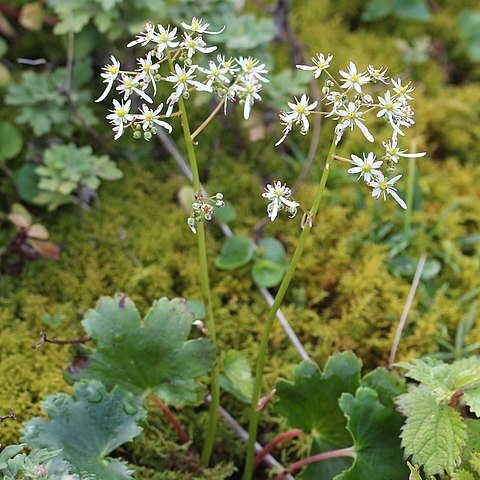Plants 24-40 cm tall. Petiole 5-18.5 cm, glandular villous; leaf blade reniform to subcordate, 3.3-16 × 3.8-20 cm, abaxially glandular villous, palmately veined, base cordate, margin 7-11-lobed; lobes broadly ovate, margin irregularly dentate, glandular ciliate, apex obtuse or acute. Scape red-brown crisped glandular villous. Inflorescence paniculate, 11.5-32 cm, ca. 35-flowered; branches slender, 6-6.5 cm, glandular hairy; bracts narrowly triangular, 7-8 mm, abaxially and marginally glandular villous. Sepals spreading to reflexed, subovate, 1-3.5 × 0.9-1.5 mm, abaxially (or both surfaces) and marginally glandular hairy, veins 3 and confluent at apex or 1, apex obtuse or acute. Petals 5, white to reddish; shortest 3 petals ovate, 1.3-4.1 × 0.9-1.7 mm, 3-veined, base rounded, with a claw 0.2-0.3 mm, margin glandular ciliate or glabrous, apex subacuminate or acuminate; longer petal narrowly ovate, 0.7-1.7 cm × 2-5.3 mm, 3-7-veined, base with a claw 0.2-0.6 mm, margin glandular ciliate or glabrous, apex acuminate; longest petal narrowly ovate, 1.2-2.4 cm × 2.8-6.5 mm, 3-8(-14)-veined, base gradually contracted into a claw 0.6-1.5 mm, margin serrate or entire, glandular ciliate or glabrous, apex acuminate or subacuminate. Stamens 4-5 mm. Carpels 3.2-4 mm; ovary ovoid; styles divergent. Fl. Jun-Jul.
More
A perennial herb. It grows 30-45 cm high and 30-38 cm wide. The leaves are overlapping and with scalloped edges. The leaves are kidney shaped or round. They are 10 cm long. They are purplish red underneath. There is one or more petals in each flower that is longer than the others. The flowers are white and on stems 50 cm long.

